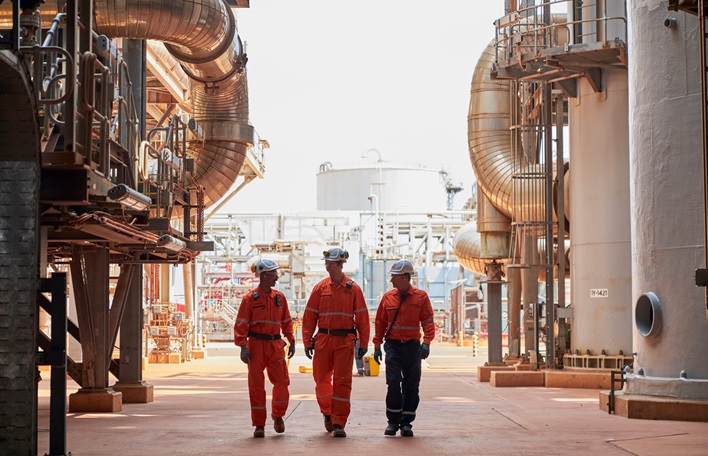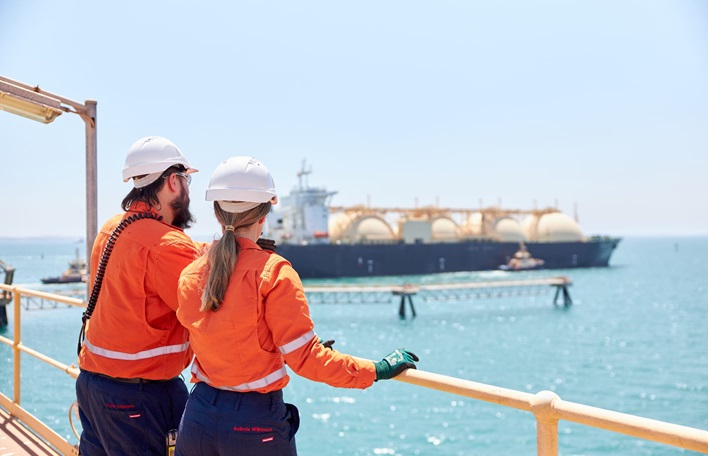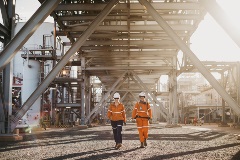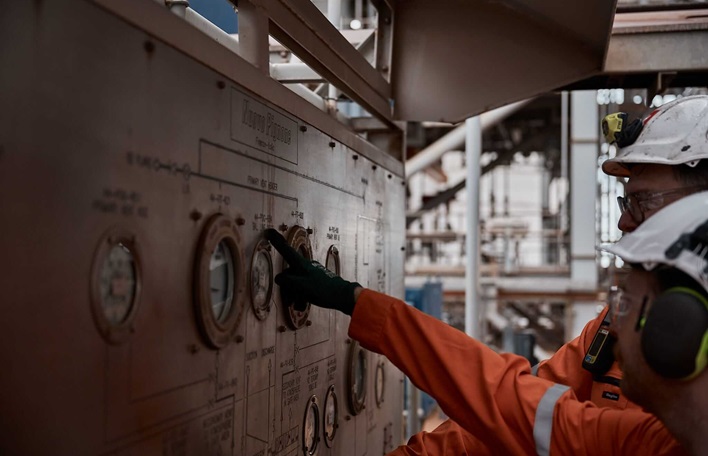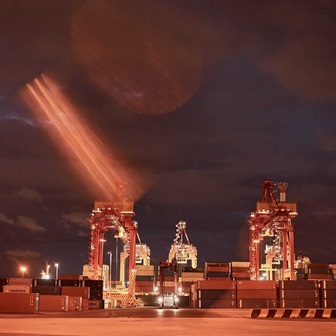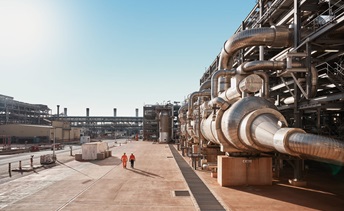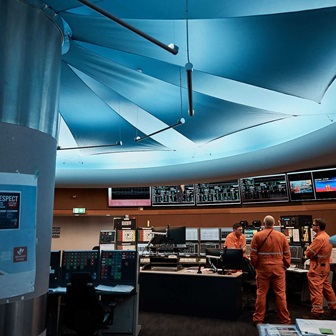
Climate-related risk management
Risks and opportunities
The key climate-related risks and opportunities table describes the potential impact to Woodside’s business, strategy, and financial planning, including potential impacts on both financial position and performance and potential mitigations. This does not necessarily mean that the risks have materialised in practice or that the mitigations are currently being pursued. The table is presented using the TCFD framework.
Key climate-related risks and opportunities
*Timeframe:1 S: now to 2025 (short) M: 2026-2035 (medium) L: 2036 and beyond (long)
The global transition to a lower carbon economy may entail extensive policy, legal, technology and market changes in order for the world to address mitigation and adaptation requirements relating to climate change.
| Timeframe* | Type of potential impact | Potential financial impacts | Potential mitigations | ||
|---|---|---|---|---|---|
| S | M | L | |||
| Policy and legal risks | |||||
| Exposure to litigation |
|
| |||
| Delays to, or failure to obtain, regulatory approvals | |||||
| Increased pricing or other regulatory control of emissions | |||||
| Mandates or controls on hydrocarbon product use or access to growth acreage | |||||
| Increased emissions reporting requirements | |||||
| Technology | |||||
| Unsuccessful investment in new technologies |
|
| |||
| Higher than expected costs of transition to new technologies | |||||
| Overreliance on policy support to support commerciality | |||||
| Technology disruption | |||||
| Inability to develop at scale due to competition for resources, people or technology | |||||
| Market | |||||
| Faster than expected substitution of hydrocarbon products |
|
| |||
| Slower than expected adoption of new energy and lower carbon services | |||||
| Slower than expected phase-out of coal | |||||
| Uncertainty/regional variation in transition pathways | |||||
| Demand destruction due to disorderly transition or being an unpreferred provider | |||||
| Reputation | |||||
| Increased stakeholder concern |
|
| |||
| Targets fail to meet stakeholder expectations | |||||
| Stigmatisation of hydrocarbon energy sector | |||||
| Constrained access to talent | |||||
| Constrained access to debt capital and insurance | |||||
| Inability to pursue range of climate-related pathways | |||||
| Targeted extreme activism | |||||
Physical risks from climate change may have financial implications for organisations such as direct damage to assets and indirect impacts from supply chain disruption.
| Timeframe* | Type of potential impact | Potential financial impacts | Potential mitigations | ||
|---|---|---|---|---|---|
| S | M | L | |||
| Acute | |||||
| Increased frequency, severity and/or duration of extreme weather events, such as tropical cyclones, hurricanes, rainfall, flooding, storm surge, lightning, squalls, bushfires and/or heat waves |
|
| |||
| Chronic | |||||
| Longer-term shifts in climate patterns, such as warmer ambient temperatures, rising sea levels, coastal erosion, reduced water availability, and lower rainfall in tree planting areas |
|
| |||
Efforts to mitigate and adapt to climate change also produce opportunities for organisations.
| Timeframe* | Type of potential impact | Potential financial impacts | Potential mitigations | ||
|---|---|---|---|---|---|
| S | M | L | |||
| Resource efficiency | |||||
| Fuel gas savings diverted to sales gas |
|
| |||
| More efficient shipping fleet | |||||
| More efficient building stock | |||||
| Recycling of decommissioned materials | |||||
| Reduce methane losses | |||||
| Energy source | |||||
| Use of renewable energy generation |
|
| |||
| Use of efficient technologies | |||||
| Use of energy storage | |||||
| Products and services | |||||
| Diverse portfolio of products and services including natural gas in decarbonisation pathways |
|
| |||
| Development of new energy products and lower-carbon services | |||||
| New technologies for forecasting physical risk | |||||
| Markets | |||||
| Use of public sector incentives |
|
| |||
| Collaborative partnership with customers, research institutions and broader industry organisations | |||||
| Access to new markets | |||||
| Resilience | |||||
| Broader portfolio inclusive of oil, gas and new energy opportunities |
|
| |||
| Access to sustainable finance | |||||
| Decrease climate risk in the supply chain | |||||
| Capital allocations strategy to flex between product streams | |||||
Managing physical risks
Woodside’s assets are designed to withstand extreme weather events, we have specialised teams that support the safe and reliable design and operation of our facilities.
Physical risks can arise from both event driven (acute) and longer-term shifts (chronic) in climate patterns. These physical risks may have financial implications for organisations.
For example, in the oil and gas industry, this might include harsh weather or ocean conditions that can damage or disrupt the ability to safely operate offshore facilities, shipping and onshore processing plants. Woodside has decades of experience designing and operating facilities located in harsh environments.
Woodside’s facilities are subject to metocean conditions and are located in regions that experience tropical cyclones, hurricanes and high ambient temperatures.
Physical risks could also impact emerging new businesses in new energy products and lower-carbon services. For example, this could include bushfire or drought risk for nature-based carbon origination projects, or access to water for use in electrolysis for hydrogen.
Examples of physical risk management
Design of Woodside’s facilities
Each Woodside facility is built in accordance with a basis of design (BOD). This details, amongst other things, the climatic conditions that facilities need to withstand. Each BOD is reviewed against updates to climatic conditions and, where required, actions are taken to update procedures or replace/ refurbish equipment to withstand the revised conditions.
For new facilities and refurbishments, the requirements for maximum air temperature and sea level in the BODs are aligned to IPCC Shared Socioeconomic Pathway 2-4.5 (the SSP 2-4.5) in which global temperatures rise by 2.7°C by the end of the century. Design sensitivities are also performed against SSP 5-8.5 pathway in which global temperatures rise by 4.4°C. (Note that the BOD is intended to describe harsh environmental conditions that a facility may need to withstand over the course of the facility lifespan, hence the alignment with and sensitivities for higher temperature outcomes by 2100 rather than 2°C or 1.5°C global temperature rise outcomes).4
Woodside designs its assets to withstand extreme weather events that occur in the range of 1 in 1,000 years to 1 in 10,000 years. This is also specified in each BOD.5 These time periods and the approach of using IPCC SSPs has historically been used at heritage Woodside assets and will be incorporated across the merged portfolio for new assets.
Woodside Capability
| Some relevant teams within the Woodside organisation include: | |
|---|---|
| Meteorology and Oceanography (metocean) | Metocean specialists quantify the potential impact and effect of meteorological and oceanographic conditions on Woodside’s facilities. This includes waves, climate variability, tropical cyclones, hurricanes, air temperature and rainfall. This analysis is used to define technical requirements for existing and new facilities. |
| Health, Safety and Environment | Health, safety and environment specialists support the business by providing guidelines on safe operating conditions. Examples include the wellbeing of people working in high ambient temperature environments and maintenance of safety critical systems and equipment. |
| Asset Management | Asset management teams are responsible for managing asset specific risks, such as structural integrity risks from weather related events and risks to production forecasts from weather related outages. Regular risk governance meetings are held to review the management of these risks. |
| Emergency Management | Emergency management specialists support the business in the development of emergency response plans and capabilities and with response to any emergency events. This includes preparation for and response to tropical cyclones and hurricanes. |

